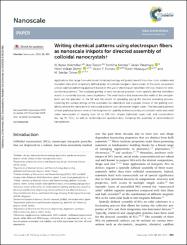Writing chemical patterns using electrospun fibers as nanoscale inkpots for directed assembly of colloidal nanocrystals

View/
Access
info:eu-repo/semantics/openAccessDate
2020Author
Kiremitler, N. BurakTorun, Ilker
Altintas, Yemliha
Patarroyo, Javier
Demir, Hilmi Volkan
Puntes, Victor F.
Mutlugun, Evren
Onses, M. Serda
Metadata
Show full item recordAbstract
Applications that range from electronics to biotechnology will greatly benefit from low-cost, scalable and multiplex fabrication of spatially defined arrays of colloidal inorganic nanocrystals. In this work, we present a novel additive patterning approach based on the use of electrospun nanofibers (NFs) as inkpots for end-functional polymers. The localized grafting of end-functional polymers from spatially defined nanofibers results in covalently bound chemical patterns. The main factors that determine the width of the nanopatterns are the diameter of the NF and the extent of spreading during the thermal annealing process. Lowering the surface energy of the substrates via silanization and a proper choice of the grafting conditions enable the fabrication of nanoscale patterns over centimeter length scales. The fabricated patterns of end-grafted polymers serve as the templates for spatially defined assembly of colloidal metal and metal oxide nanocrystals of varying sizes (15 to 100 nm), shapes (spherical, cube, rod), and compositions (Au, Ag, Pt, TiO2), as well as semiconductor quantum dots, including the assembly of semiconductor nanoplatelets.

















